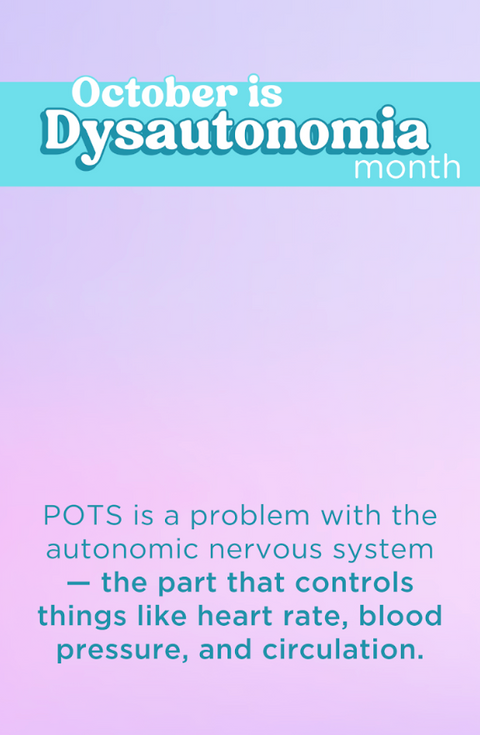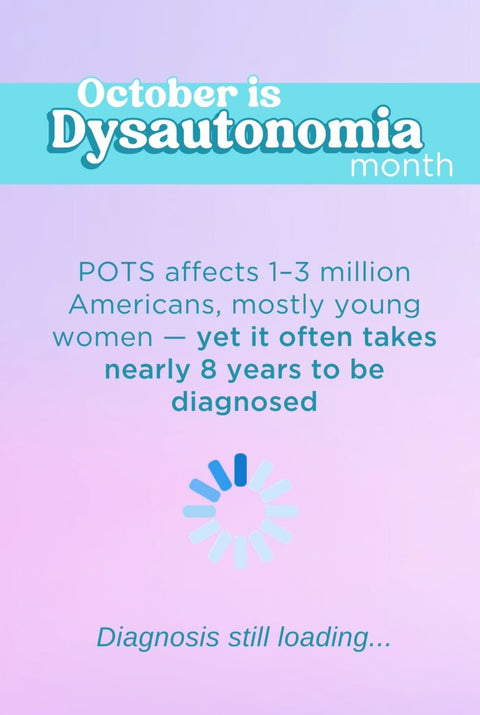For many people, Postural Orthostatic Tachycardia Syndrome (POTS) is an unfamiliar term. Yet, for those living with it, POTS is a daily challenge that affects everything from standing up to focusing on a task at school or work. Because POTS is complex, it often goes unrecognized. But the good news is this: POTS is explainable, and understanding it builds empathy, speeds up recognition, and helps people feel less alone.
POTS is short for Postural Orthostatic Tachycardia Syndrome, a form of dysautonomia. Dysautonomia is an umbrella term for disorders of the autonomic nervous system (ANS). The ANS is the body’s autopilot—it controls things we don’t have to think about, like heart rate, blood pressure, digestion, and circulation. In POTS, the ANS doesn’t regulate blood flow properly when a person moves from lying down to standing up. Instead of smoothly shifting blood to the brain and upper body, the circulation gets stuck in the lower body. The brain isn’t getting enough oxygen-rich blood, so the body compensates by sending the heart rate soaring.
A simple way to picture it is to think of the body like a traffic system. When most people stand up, the traffic lights (the autonomic nervous system) redirect blood flow so it keeps moving to the brain. In someone with POTS, the lights don’t change properly, and traffic piles up in the wrong place. The result is that the brain doesn’t get the blood supply it needs quickly enough. That’s why standing up can trigger symptoms like dizziness, blurred vision, or even fainting. It’s not about being weak, lazy, or anxious—it’s about a wiring issue in the body’s circulation system.
Symptoms of POTS can vary widely, but there are some that appear most often. Many people experience dizziness or lightheadedness when standing up. A rapid heartbeat, known as tachycardia, is another hallmark symptom. Fatigue that isn’t relieved by rest is common, along with brain fog—difficulty concentrating, remembering, or processing information. Some patients faint or nearly faint, while others notice that exercise makes their symptoms worse instead of better. These symptoms can fluctuate day to day, making life unpredictable. A student might manage school one day but struggle to get out of bed the next. A parent might be fine doing chores one morning but crash by afternoon.
Because many POTS symptoms overlap with stress or anxiety—like a racing heart or feeling lightheaded—the condition is often mistaken for a psychological problem. This misunderstanding delays diagnosis and leaves patients feeling unheard. But POTS is not caused by anxiety. It is a medical condition rooted in the autonomic nervous system. That said, living with unpredictable symptoms can naturally cause stress and worry. Anyone facing dizziness, fatigue, and fainting on a regular basis would understandably feel anxious. Recognizing this distinction is essential for empathy and proper care.
The more people understand POTS, the easier it becomes for patients to be recognized and supported. Awareness isn’t just about naming the condition—it’s about building empathy. For patients, understanding means validation: “My symptoms are real, and I’m not imagining them.” For families and friends, it offers a roadmap for compassion: “This isn’t laziness—it’s a condition affecting blood flow.” For doctors and teachers, it makes earlier recognition possible, cutting down years of misdiagnosis. In fact, studies have shown that awareness can shorten the time to diagnosis from nearly a decade to just a few months. That’s a powerful reminder that knowledge saves both time and suffering.
Life with POTS is challenging, but it’s not without hope. Treatments vary, but common strategies include increasing fluids and salt intake to boost blood volume, wearing compression garments to support circulation, physical therapy or gradual exercise programs, and medications to help regulate heart rate and blood pressure. Support also plays a big role. Friends and family who understand POTS can offer encouragement and patience. Simple accommodations—like sitting instead of standing in long lines, or adjusting schedules to allow for rest—can make a big difference.
One of the most powerful outcomes of POTS education is empathy. When people realize the condition is rooted in biology, not behavior, their perspective shifts. Suddenly, fainting in a classroom or needing extra time to recover from activity makes sense. Understanding also breaks isolation. Patients often say that learning about POTS makes them feel less alone. When friends, family, and even strangers understand, the burden of explanation doesn’t rest solely on the patient.
While this article focuses on POTS, it’s part of the larger family of dysautonomia disorders. Dysautonomia can also include conditions like neurocardiogenic syncope (NCS) and multiple system atrophy (MSA). Each involves dysfunction in the autonomic nervous system, though they vary in severity and symptoms. By understanding POTS, we also build awareness of dysautonomia as a whole. This strengthens advocacy efforts, funding for research, and the push for better treatments across all related conditions.
Even if you don’t have POTS, you can be part of the movement for better recognition and support. Learning about the condition, listening to patients, sharing information during Dysautonomia Awareness Month in October, and offering support to friends or family members with POTS all help. Every conversation, social post, or act of empathy makes POTS a little less invisible.
POTS is complex, but it doesn’t have to be confusing. When explained in simple terms, it becomes clear: POTS is a circulation problem rooted in the autonomic nervous system, not a character flaw or mental weakness. The more we understand, the faster we can build empathy, shorten diagnosis times, and support those living with this condition. By demystifying POTS, we create a world where patients feel heard, families feel empowered, and communities grow stronger. Awareness starts with understanding—and understanding starts with you.




Comments (0)
There are no comments for this article. Be the first one to leave a message!